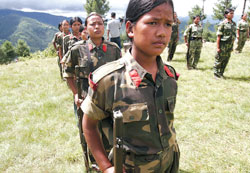|
|
| WAR CLASS: Young Maoist soldiers on parade in Kabhre. Rebels say they are not underage. |
. 15-year-old Abhin from Dhading is a popular composer and singer-of Maoist revolutionary songs that encourage more children like him to join the PLA.
. Yamu Sonu Lama from Makawanpur was 16 when she joined the Maoists and now, at 18, is a section commander.
. Ramu, 18, from Ramechhap has been a frontline fighter in many Maoist military operations.
. The Nepal Army has used children too, as messengers and spies. Not being combatants didn't protect them from capture and torture by the Maoists.
The insurgency, and the armed forces' response to it, have had appalling consequences for children. They have been forcefully recruited by the Maoists or tortured for being 'informants', and been arbitrarily detained and then 'disappeared' by the army and police for alleged involvement in Maoist activities.
UNICEF defines a child soldier as any boy or girl under 18 involved with a regular armed force or group. This definition is not restricted to combatants-it also includes those involved in any other capacity, such as cooks, porters, or informers.
The international children's watchdog, Watchlist on Children and Armed Conflict, claims that up to 30 percent of the Maoist forces may be children. Human rights group Insec estimates that around 345 children have died at the hands of the Maoists and the state between 17 February 1996 to June 2006.
Yet children are nowhere in the peace process. Not one discussion has focused on children, and there has been no mention of how child soldiers are to be integrated during discussions on demobilisation, demilitarisation, and reintegration (DDR) of the people's liberation army. The government has not drafted any plans and policies for demobilising and rehabilitating child soldiers, and the Maoists want to wait until political issues are resolved.
Under these circumstances, child soldiers will be hesitant about leaving the Maoist army, particularly given past experience. During the second round of peace talks in 2003 , a number of children returned to their families. However, no demobilisation and reintegration agreement was discussed between the government and the Maoists, and when the talks broke down, all these children were recalled to the PLA.
"Removing children from any activity linked to armed conflict is essential and should not be dependent on any adult DDR process, peace talks, peace agreements or cessation of hostilities," stresses Sandra Beidas, chief of the protection section of the UN's Nepal Office of the High Commission for Human Rights.
The psychological and sociological scars are as serious as the physical, and will only get worse the longer we wait. "Child DDR should start as soon as possible. Early intervention is critical for the normal development of children even without a peace process. If you don't act now, it could be too late," explains Rosanna Vega, a child protection officer with UNICEF, which is working with child protection agencies to prepare an action plan for child DDR.
Other countries have dealt with demobilising and rehabilitating child soldiers during a ceasfire but before a formal peace process. In Sri Lanka in 2003, for example, while the peace talks were going on the UN worked with the LTTE to release over 600 child soldiers and develop a plan for social reintegration and education of the returning children. In Sierra Leone, the child-focused DDR process helped to demobilise over 6,000 child soldiers who were then sheltered in interim care centres between 1998-2002. The success of these two programs, UNICEF experts say, came from the fact that the children had access to education and community support.
In the absence of an official child DDR program, a network called Children Associated with Armed Groups and Force has already been set up to help former child soldiers with rehabilitation, social integration and psycho-social counselling. "The immediate step should be to form a national child protection policy to ensure safe return, free education, vocational training and, most importantly, immunity to former child combatants," explains child-rights expert Bhola Dahal of Save the Children (Norway).
The start of a UN-brokered peace deal could be what's needed to speed up the process, as UN Security Council Resolution 1314 stresses that national governments in such situations must include provisions for DDR of child combatants in peace agreements.
In the meantime, the agency's action plan is taking shape, and will be based on the UN experiences in successfully advocating and securing the release of children from armed forces in a number of countries, including Afghanistan, Angola, the Democratic Republic of the Congo, Liberia, Rwanda, Somalia, and Sudan.
(Names of the children have been changed to protect their identity.)
Comment at Nepali Times Blog



